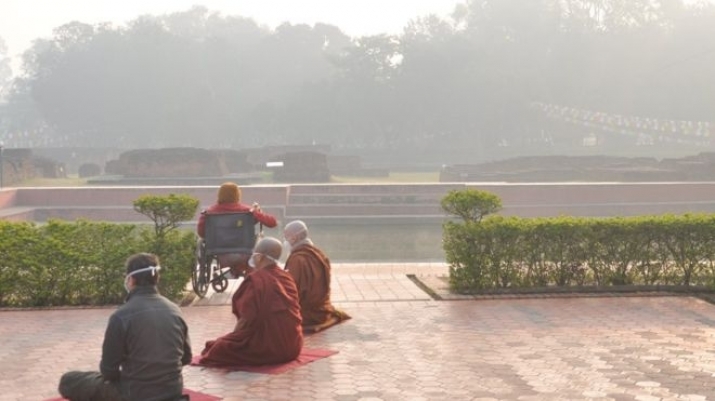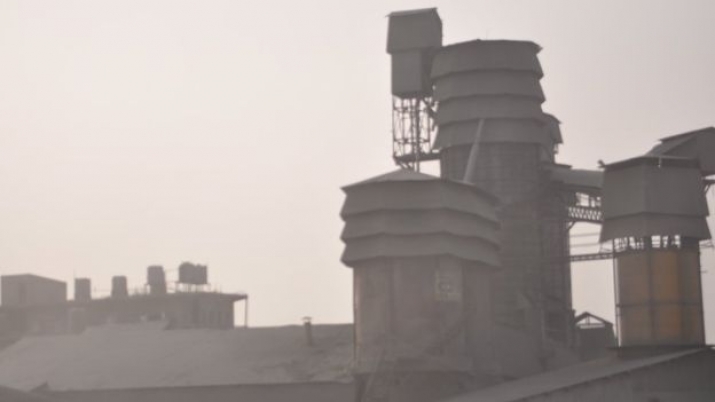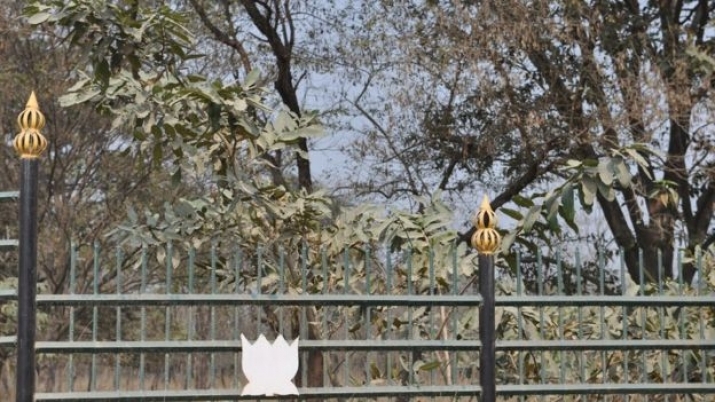NEWS
Air Pollution Levels Threaten Birthplace of the Buddha
 Monks wear masks as protection against the thick air pollution at the Buddha's birthplace. From bbc.com
Monks wear masks as protection against the thick air pollution at the Buddha's birthplace. From bbc.comScientists and government officials have warned that Lumbini, the birthplace of the Buddha, is under serious threat from air pollution. Data for January indicates that the Buddhist pilgrimage site in the Rupandehi District of Nepal had the highest concentration of fine particulate matter in the country for that month, which has been attributed to rapid industrialization in areas surrounding the sacred site.
The measured level of fine particulate matter that can enter the human bloodstream per cubic meter (PM2.5) was 173.035 micrograms in January, compared with the World Health Organization (WHO) safe limit of 25 micrograms (the government of Nepal has a standard of 40 micrograms).
The Indian Institute of Tropical Meteorology, which conducted a study of the pollution levels in association with the WHO, offered the following explanation: “The combined effect of trans-boundary transport from the pollution-rich Indo-Gangetic Plain region and trapped local industrial pollution due to temperature inversion is responsible for severe winter pollution. . . . For other seasons, local emissions are largely responsible for bad air quality.” (BBC News)
 Cement factories in the area are said to be responsible for the high pollution levels. From bbc.com
Cement factories in the area are said to be responsible for the high pollution levels. From bbc.comThe Nepalese government has designated a 15-square-kilometer area around the sacred site as the Lumbini Protected Zone. Just outside this zone, lies a growing industrial corridor with cement, paper, steel, and noodle factories, as well as brick kilns, some of which have been constructed within the protected zone, in violation of regulations.
Factory operators, however, argue that they are at a reasonable distance from the site and not the only ones to blame for the pollution. “Yes, certainly this is very near to the birthplace of Lord Gautam Buddha,” said Ajay Ajad, manager of the biggest cement factory in the area. “Obviously cement factories emit some dust, but we are at a reasonably safe distance and therefore the deposition of our dust particles on the sacred site is minimized. . . . [The dust] is all over Nepal and even at places where there are no cement factories.” (BBC News)
Researchers of a separate study conducted by the International Union for Conservation of Nature and UNESCO, however, have found traces of gypsum, calcite, dolomite, and magnesite deposits on the surface of the pillar of Ashoka, build in 249 BCE by the Mauryan emperor Ashoka (r. c. 268–c. 232 BCE) as a marker of Buddha’s birthplace. According to Italian archaeologist Constantino Meucci of the University of Rome, these are “all compounds part of the cement production cycle.” (BBC News)
 Plants and trees around the sacred site are covered in dust. From bbc.com
Plants and trees around the sacred site are covered in dust. From bbc.comThe pollution is not only affecting archeological structures at the site, it is also a threat to biodiversity and a health hazard for local residents and visitors.
“At times I have difficulty in breathing properly and I have to cough. . . . We had at our meditation center certain [people] who have had asthma conditions and during their stay here in Lumbini, it has badly affected them. . . . In at least three cases, [they] had to cut their retreat short and go back because they could not tolerate the conditions here any more,” related Vivekananda, a monk who runs an international meditation center in Lumbini. (BBC News)
Shankar Gautam, a retired health official, noted: “When the wind brings more pollution, we see many monks meditating here with their masks on. . . . Studies have shown that in the past 10 years the number of people with lung related diseases has gone up. . . . The dust coming in here has also led to a huge increase in skin-related diseases.” (BBC News)
Last year, 1 million tourists and monks visited the holy site, which the government aims to promote as a global tourism and pilgrimage destination. Government officials acknowledge the severity of the situation and have pledged to take action against the pollution: “We plan to detect the sources of the pollution using a drone in the near future and hopefully this will help minimize the problem.” (BBC News)
See more
Buddha's birthplace faces serious air pollution threat (BBC News)
Air pollution levels higher in Lumbini than in Ratnapark (The Himalayan Times)
Related news from Buddhistdoor Global
UNESCO Head Commends International Conservation Effort in Lumbini
Related features from Buddhistdoor Global
India: Buddha epic to boost birthplace campaign
UNIDO, APECF sign memo for development project in Buddha's birthplace
Buddha Touched the Earth: An Exploration of Engaged Buddhism














